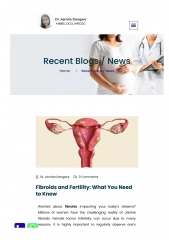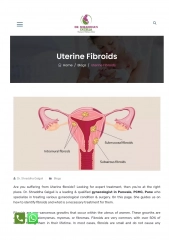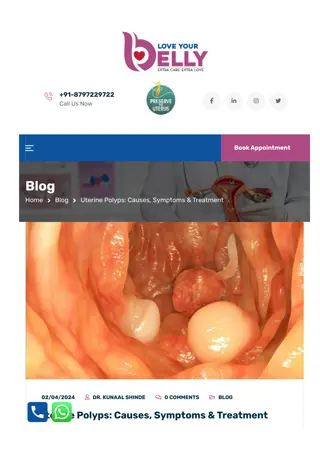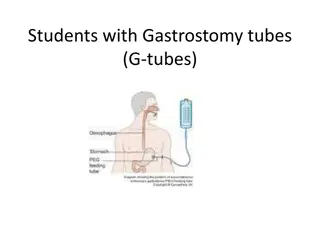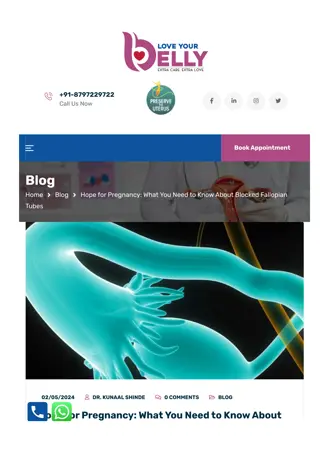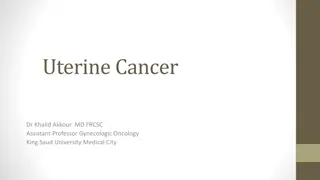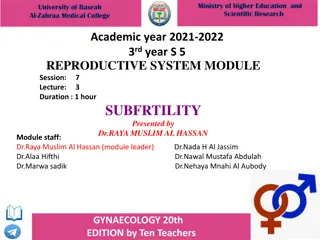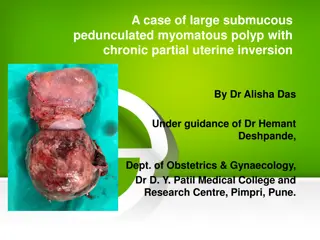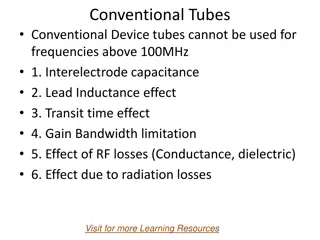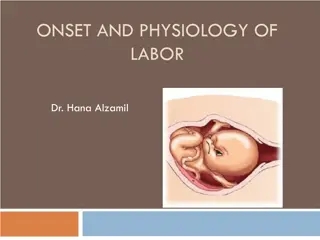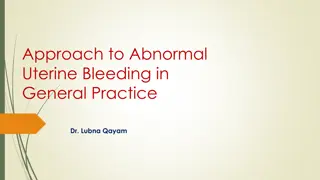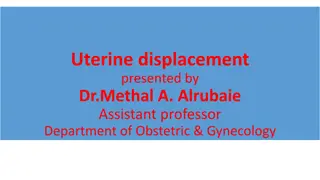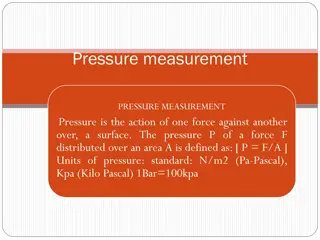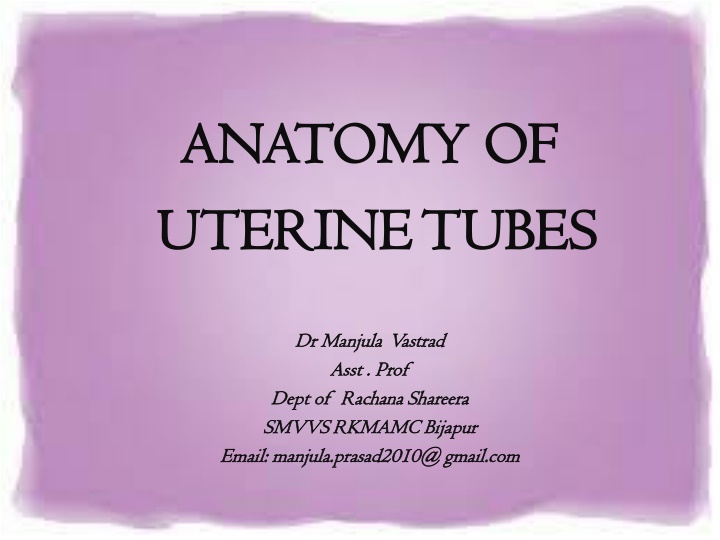
Uterine Tubes Anatomy: Structure, Dimensions, and Functions
Explore the detailed anatomy of uterine tubes, including their definition, situational aspects, dimensions, parts, histology, functions, anatomical relations, blood and nerve supply, lymphatic drainage, and applied anatomy. Learn about the four parts of the uterine tube and their respective measurements. Gain insights into the intricate structure and functions of this essential organ in the female reproductive system.
Download Presentation

Please find below an Image/Link to download the presentation.
The content on the website is provided AS IS for your information and personal use only. It may not be sold, licensed, or shared on other websites without obtaining consent from the author. If you encounter any issues during the download, it is possible that the publisher has removed the file from their server.
You are allowed to download the files provided on this website for personal or commercial use, subject to the condition that they are used lawfully. All files are the property of their respective owners.
The content on the website is provided AS IS for your information and personal use only. It may not be sold, licensed, or shared on other websites without obtaining consent from the author.
E N D
Presentation Transcript
ANATOMY OF ANATOMY OF UTERINE TUBES UTERINE TUBES Dr Manjula Vastrad Dr Manjula Vastrad Asst . Prof Asst . Prof Dept of Rachana Shareera Dept of Rachana Shareera SMVVS RKMAMC Bijapur SMVVS RKMAMC Bijapur Email: manjula.prasad2010@ gmail.com Email: manjula.prasad2010@ gmail.com
CONTENTS 1.DEFINITION 2.SITUATION 3.DIMENSIONS 4.PARTS 5.HISTOLOGY 6.FUNCTIONS 7.ANATOMICAL RELATIONS 8.BLOOD & NERVE SUPPLY 9.LYMPHATIC DRIANAGE 10.APPLIED ANATOMY.
1.DEFINITION They are tortuous ducts which convey oocyte from the ovary to the uterus. Syn fallopian tube, oviduct
2.SITUATION Uterine tubes are paired structures. situated in the free upper margin of the broadligament of uterus. Each tube has got 2 openings, 1. one communicating with the lat.angle of uterine cavity called uterine opening. 2. The other is on the lateral end of the tube ,called pelvic opening or abdominal ostium. Tube connects the peritoneal cavity in the region of the ovary with the cavity of the uterus.
3.DIMENSIONS Uterine tubes are measuring about 10cm long. uterine opening measures about 1mm in dm. Pelvic opening or abdominal ostium measures about 2mm in dm.
4.PARTS The uterine tube is divided into four parts: From medial to lateral are: 1. intramural or interstial 2. isthmus 3. ampulla 4. infundibulum
1. INTERSTITIAL PART Lying in the uterine wall. Measures 1.25cm in length 1mm in dm.
2.ISTHMUS Almost straight measures about 2.5 cm in length 2.5mm in dm.
3.AMPULLA Tortuous part Measures about 5cm in length It ends in wide infundibulum.
4.INFUNDIBULUM Measuring about 1.25 cm long. 6mm in dm. The abdominal ostium is surrounded by a no.of radiating fimbriae, one of these is longer than the rest & is attached to the outer pole of the ovary called ovarian fimbriae.
5.Histology of the Fallopian tubes Serosa (peritoneal covering): covered by peritoneum in the upper margin of the broad ligament. Muscle layer: Outer longitudinal and inner circular involuntary smooth muscles. It is thick at the isthmus and thin at the ampulla. Mucosa (endosalpnix): It is lined by columnar partially ciliated epithelium. It is thrown into longitudinal folds.
6.FUNCTION Ovum Pick Up, at the time of ovulation, by their free fimbrial end, Transport Of The Ova through the tubal lumen, by their peristaltic and ciliary movements, Production Of Secretions necessary for capacitation of the sperm and nutrition of the ova during their journey, by their lining cells.
7.ANATOMICAL RELATIONS Bounded above by loops of intestine below by the broad ligament and its contents. medially they blends with cornu of the uterus while laterally they are bounded by the lateral pelvic wall. The ovaries lie posterior and inferior to the Fallopian tubes at each side.
8.BLOOD SUPPLY Arterial supply: The uterine artery from the internal iliac artery and the ovarian artery from the abdominal aorta Venous drainage: Right ovarian vein drains directly into the IVC Left ovarian vein drains into the left renal vein.
Lymphatic drainage: para-aortic LNs directly via ovarian lymphatics. Nerve supply sympathetic and parasympathetic nerve fibresfrom the inferior hypogastric plexuses
10.APPLIED ANATOMY 1.TUBAL PAIN: Tubal pain is referred to the tubal points (On the lower abdominal wall 1/2 an inch above the midinguinal points).
2.THE UTERINE TUBE AS A CONDUIT FOR INFECTION The uterine tube lies in the upper free border of the broad ligament and is a direct route of communication from the vulva through the vagina and uterine cavity to the peritoneal cavity.
3.PELVIC INFLAMMATORY DISEASE The pathogenic organism(s) enter the body through sexual contact and ascend through the uterus and enter the uterine tubes. Salpingitis may follow, with leakage of pus into the peritoneal cavity, causing pelvic peritonitis. A pelvic abscess usually follows, or the infection spreads farther, causing general peritonitis.
4.ECTOPIC PREGNANCY Implantation and growth of a fertilized ovum may occur outside the uterine cavity in the wall of the uterine tube
5.TUBAL LIGATION Ligation and division of the uterine tubes is a method of obtaining permanent birth control and is usually restricted to women who already have children. The ova that are discharged from the ovarian follicles degenerate in the tube proximal to the obstruction. If, later, the woman wishes to have an additional child, restoration of the continuity of the uterine tubes can be attempted, and, in about 20% of women, fertilization occurs.
EmbryologicDevelopment of the Uterine Tube Early on in development, the paramesonephric ducts appear on the posterior abdominal wall on the lateral side of the mesonephros. The uterine tube on each side is formed from the cranial vertical and middle horizontal parts of the paramesonephric duct . The tube elongates and becomes coiled; differentiation of the muscle and mucous membrane takes place; the fimbriae develop; and the infundibulum, ampulla, and isthmus are identifiable.

